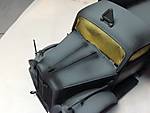Vallejo paint was flat amazing to airbrush, with little finicky thinning issues. Tamiya paints took some work to get right, but man were they troublesome.
My biggest concern was why I couldn't seem to get the paints to not over spray (I think that's the term?) like the photo below:

Here's what it was looking like on the model (as I attempted modulation the first time too!):

I'm using a Paasche H single action airbrush. Tried various air pressures and thinning ratios, as well as needle adjustments, got similar results.
Any ideas or thoughts how to best solve this?
As always, thanks to my international team of expert instructors!























